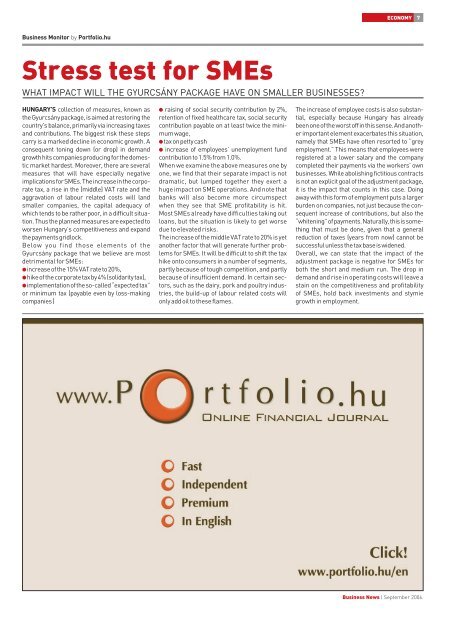You also want an ePaper? Increase the reach of your titles
YUMPU automatically turns print PDFs into web optimized ePapers that Google loves.
ECONOMY 7Business Monitor by Portfolio.huStress test for SMEsWHAT IMPACT WILL THE GYURCSÁNY PACKAGE HAVE ON SMALLER BUSINESSES?HUNGARY’S collection of measures, known asthe Gyurcsány package, is aimed at restoring thecountry’s balance, primarily via increasing taxesand contributions. The biggest risk these stepscarry is a marked decline in economic growth. Aconsequent toning down (or drop) in demandgrowth hits <strong>com</strong>panies producing for the domesticmarket hardest. Moreover, there are severalmeasures that will have especially negativeimplications for SMEs. The increase in the corporatetax, a rise in the (middle) VAT rate and theaggravation of labour related costs will landsmaller <strong>com</strong>panies, the capital adequacy ofwhich tends to be rather poor, in a difficult situation.Thus the planned measures are expected toworsen Hungary’s <strong>com</strong>petitiveness and expandthe payments gridlock.Below you find those elements of theGyurcsány package that we believe are mostdetrimental for SMEs:●increase of the 15% VAT rate to 20%,●hike of the corporate tax by 4% (solidarity tax),●implementation of the so-called “expected tax”or minimum tax (payable even by loss-making<strong>com</strong>panies )● raising of social security contribution by 2%,retention of fixed healthcare tax, social securitycontribution payable on at least twice the minimumwage,●tax on petty cash● increase of employees’ unemployment fundcontribution to 1.5% from 1.0%.When we examine the above measures one byone, we find that their separate impact is notdramatic, but lumped together they exert ahuge impact on SME operations. And note thatbanks will also be<strong>com</strong>e more circumspectwhen they see that SME profitability is hit.Most SMEs already have difficulties taking outloans, but the situation is likely to get worsedue to elevated risks.The increase of the middle VAT rate to 20% is yetanother factor that will generate further problemsfor SMEs. It will be difficult to shift the taxhike onto consumers in a number of segments,partly because of tough <strong>com</strong>petition, and partlybecause of insufficient demand. In certain sectors,such as the dairy, pork and poultry industries,the build-up of labour related costs willonly add oil to these flames.The increase of employee costs is also substantial,especially because Hungary has alreadybeen one of the worst off in this sense. And anotherimportant element exacerbates this situation,namely that SMEs have often resorted to “greyemployment.” This means that employees wereregistered at a lower salary and the <strong>com</strong>pany<strong>com</strong>pleted their payments via the workers’ ownbusinesses. While abolishing fictitious contractsis not an explicit goal of the adjustment package,it is the impact that counts in this case. Doingaway with this form of employment puts a largerburden on <strong>com</strong>panies, not just because the consequentincrease of contributions, but also the“whitening” of payments. Naturally, this is somethingthat must be done, given that a generalreduction of taxes (years from now) cannot besuccessful unless the tax base is widened.Overall, we can state that the impact of theadjustment package is negative for SMEs forboth the short and medium run. The drop indemand and rise in operating costs will leave astain on the <strong>com</strong>petitiveness and profitabilityof SMEs, hold back investments and stymiegrowth in employment.Business News | September 2006.




